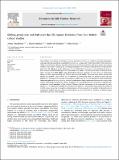Files in this item
Sibling group size and BMI over the life course : evidence from four British cohort studies
Item metadata
| dc.contributor.author | Chanfreau, Jenny | |
| dc.contributor.author | Barclay, Kieron | |
| dc.contributor.author | Keenan, Katherine | |
| dc.contributor.author | Goisis, Alice | |
| dc.date.accessioned | 2022-07-07T13:30:20Z | |
| dc.date.available | 2022-07-07T13:30:20Z | |
| dc.date.issued | 2022-09-01 | |
| dc.identifier | 280227793 | |
| dc.identifier | 30abe8be-923b-4505-a364-c3148c730a93 | |
| dc.identifier | 000861098100001 | |
| dc.identifier | 85146531962 | |
| dc.identifier.citation | Chanfreau , J , Barclay , K , Keenan , K & Goisis , A 2022 , ' Sibling group size and BMI over the life course : evidence from four British cohort studies ' , Advances in Life Course Research , vol. 53 , 100493 . https://doi.org/10.1016/j.alcr.2022.100493 | en |
| dc.identifier.issn | 1040-2608 | |
| dc.identifier.other | crossref: 10.1016/j.alcr.2022.100493 | |
| dc.identifier.other | ORCID: /0000-0002-9670-1607/work/114977524 | |
| dc.identifier.uri | https://hdl.handle.net/10023/25622 | |
| dc.description | Funding: JC and AG were supported by the UK Economic and Social Research Council (ESRC) grant number ES/S002103/1 and the ESRC CLS Centre (ES/M001660/1). KB was supported by the Bank of Sweden Tercentenary Foundation (Riksbankens Jubileumsfond) through a Pro Futura Scientia XIV fellowship. KK was supported by a Carnegie Trust for the Universities of Scotland Research Incentive Grant (RIG008234) and ESRC CPC Connecting Generations Centre (ES/V014188/1). | en |
| dc.description.abstract | Only children, here defined as individuals growing up without siblings, are a small but growing demographic subgroup. Existing research has consistently shown that, on average, only children have higher body mass index (BMI) than individuals who grow up with siblings. How this difference develops with age is unclear and existing evidence is inconclusive regarding the underlying mechanisms. We investigate BMI trajectories for only children and those with siblings up to late adolescence for four British birth cohorts and across adulthood for three cohorts. We use data on BMI from ages 2–63 years (cohort born 1946); 7–55 years (born 1958); 10–46 (born 1970) and 3–17 years (born 2000–2002). Using mixed effects regression separately for each cohort, we estimate the change in BMI by age comparing only children and those with siblings. The results show higher average BMI among only children in each cohort, yet the difference is substantively small and limited to school age and adolescence. The association between sibling status and BMI at age 10/11 is not explained by differential health behaviours (physical activity, inactivity and diet) or individual or family background characteristics in any of the cohorts. Although persistent across cohorts, and despite the underlying mechanism remaining unexplained, the substantively small magnitude of the observed difference and the convergence of the trajectories by early adulthood in all cohorts raises doubts about whether the difference in BMI between only children and siblings in the UK context should be of research or clinical concern. Future research could usefully be directed more at whether only children experience elevated rates of disease, for which high BMI is a risk factor, at different stages of the life course and across contexts. | |
| dc.format.extent | 10 | |
| dc.format.extent | 702123 | |
| dc.language.iso | eng | |
| dc.relation.ispartof | Advances in Life Course Research | en |
| dc.subject | BMI | en |
| dc.subject | Only children | en |
| dc.subject | Siblings | en |
| dc.subject | Life course | en |
| dc.subject | Cross-cohorts changes | en |
| dc.subject | UK | en |
| dc.subject | RJ101 Child Health. Child health services | en |
| dc.subject | 3rd-DAS | en |
| dc.subject | MCC | en |
| dc.subject.lcc | RJ101 | en |
| dc.title | Sibling group size and BMI over the life course : evidence from four British cohort studies | en |
| dc.type | Journal article | en |
| dc.contributor.sponsor | Carnegie Trust | en |
| dc.contributor.sponsor | Economic & Social Research Council | en |
| dc.contributor.institution | University of St Andrews. School of Geography & Sustainable Development | en |
| dc.identifier.doi | 10.1016/j.alcr.2022.100493 | |
| dc.description.status | Peer reviewed | en |
| dc.identifier.grantnumber | RIG008234 | en |
| dc.identifier.grantnumber | ES/V014188/1 | en |
This item appears in the following Collection(s)
Items in the St Andrews Research Repository are protected by copyright, with all rights reserved, unless otherwise indicated.

